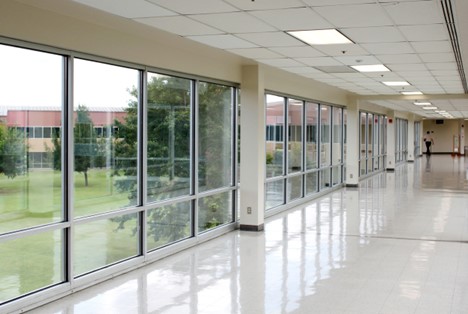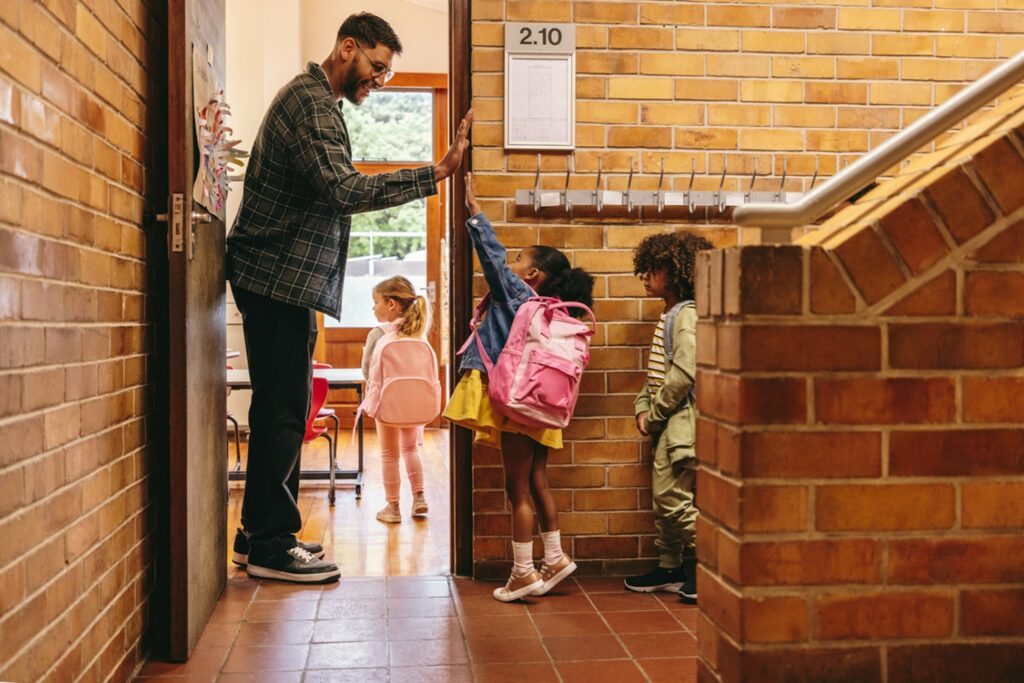Natural daylighting offers a multipurpose solution to districts by helping buildings adapt to increasingly urgent environmental initiatives while simultaneously boosting the performance of students and teachers. With the implementation of early design factors or the application of small building modifications, schools can create and save energy concurrently.

Most students have experienced the blinding glow of an impossibly bright nurse’s office, the eye strain of a fluorescent-lit basement detention room, and the headache-inducing window glare of a classroom parallel to the sun. Many of these challenges can be mitigated by the practice of daylight harvesting, which is the interdependence between natural outdoor light and supplementary artificial indoor lighting.
This technique is commonly applied through the use of strategically placed windows, transparent building features, light color palettes for reflection assistance, sun-direction factoring during zoning, prudent glare control, electric light management via sensor, and translucent manual shading options as needed. These energy-efficient design factors can improve the performance of both students and teachers while keeping electrical and temperature-control costs at a minimum.
With proper planning and integration, more schools can create atmospheres that are comfortable, eye-friendly, and environmentally sustainable.
Lumination and Learning Link
While the introduction of daylighting may not produce metaphorical light bulbs above students’ heads, it can produce tangible results related to academic performance and physical health.1 Recent research examined the impact of daylight on test taking for students within the 8 to 13-year-old range, with results indicating a performance difference of over 20% attributed to respective classroom daylight factors including window direction, glazing, shading, and size.2 Another study found correlations between daylight and student circadian cycle regulation; similar conclusions and research likely being contributing factors to the UK government’s instruction for schools to emphasize daylight in buildings.1

Beyond data, abstract benefits to students are their comfort and personal experience inside classrooms, hallways, and the entire school building. For example, children and adolescents may feel tense in clinically bright libraries or sleepy in dim hallways, but changes in architectural design or lighting modulation based on current daylight availability can provide students with favorable conditions conducive to both classes and comfort.
Ripple Effects from Teachers to Students
Daylight harvesting has the additional potential to create a ripple effect starting with teachers and staff and extending through the entire student body. Accordingly, since faculty and staff spend the most time on-premises, certain positive outcomes from daylighting may be more apparent within this adult group including circadian alignment, improved mental health symptoms, and stable personal energy levels.3 Moreover, research has been conducted on the relationship between work performance and daylight, but results have varied from an increase in cognitive acuity to minimal performance impact.4

Nonetheless, administrative spaces and classrooms with optimal daylighting can create a welcoming work environment for staff and a vibrant teaching environment for faculty that students will likely be able to detect in their instruction style and pace. This is especially advantageous for districts with ongoing hiring, turnaround, and training challenges where faculty retention is at its most imperative to meet the educational needs of students with lingering learning gaps from the pandemic.
Considerations and Changes for the Classroom
For maximum cost-effectiveness and school benefits, daylight harvesting needs to be factored into early planning for retrofits on existing buildings or, ideally, design plans for new structures. Weather patterns, regional geography, and local energy guidelines are essential location considerations, but interior design factors also play a role in both aesthetics and functionality.
Window size, quantity, and location combined with careful classroom positioning and reflective color design impact the “feel” of school interiors. It may be tempting to design an environment with transparent exterior walls, open floor plans, abundant windows, and lightly shaded paint and furniture to maximize efficacy, however, this can make spaces feel overstimulating and inaccessible for students with sensory sensitivities. As a result, it can also overwhelm staff by adding extra responsibilities of light management and glare control to their onsite duties.
To mitigate the need for staff intervention and reduce student discomfort in new buildings, window glazings with glare and temperature control, adjustable blinds or translucent shades, and automatic adjustment sensors based on a set occupancy or light visibility can be implemented. For existing buildings, it’s challenging to utilize daylighting effectively unless major renovations are budgeted, but modifications like manual light control for empty or well-lit classrooms, installation of translucent solar shades, eye-friendly artificial light bulbs, and lightly colored interiors can create a more vibrant school when remodeling is not feasible.
Expenses, Energy, and the Environment
Many schools are implementing changes as part of the Efficient and Healthy Schools Campaign, with daylight harvesting offering electric energy and expense savings associated with lighting needs; HVAC usage and costs, however, may increase or decrease depending on the sunlight’s impact on internal temperature during colder and warmer months.5
Intricate planning at the earliest building or renovation stage is crucial for districts to be able to see savings for their bottom line and benefits for their larger energy output goals. Seasonal daylight amounts, geographical sun placement, and internal adherence to daylight harvesting protocols will ultimately determine the savings cost seen by schools, but the results on learning environments and the global environment will be monumental as more schools integrate daylighting and other energy-efficient designs.
Building and Modifying Schools the ‘Light’ Way
Daylight harvesting will not automatically boost student success, improve staff performance, or stop global climate change. But, what it will immediately do is create a more productive and comfortable environment for students, teachers, employees, and visitors using the universally needed sunlight.
When planning for new school structures or considering changes in existing schools, daylighting should be one of many priorities to improve the quality of education and reduce the quantity of expenditure.
Click Here to Read More Articles Like This
- Clochet, J. B. (2022, March 10). The importance of daylighting in classrooms and its effect on primary students’ academic performance. UCL Institute for Environmental Design and Engineering. https://www.ucl.ac.uk/bartlett/environmental-design/news/2022/mar/importance-daylighting-classrooms-and-its-effect-primary-students-academic-performance
- Baloch, R. M., Maesano, C. N., Christoffersen, J., Mandin, C., Csobod, E., Fernandes, E. O., Annesi-Maesano, I., & Consortium, O. B. O. T. S. (2020). Daylight and School Performance in European Schoolchildren. International journal of environmental research and public health, 18(1), 258. https://doi.org/10.3390/ijerph18010258
- Nagare, R., Woo, M., MacNaughton, P., Plitnick, B., Tinianov, B., & Figueiro, M. (2021). Access to Daylight at Home Improves Circadian Alignment, Sleep, and Mental Health in Healthy Adults: A Crossover Study. International Journal of Environmental Research and Public Health, 18(19), 9980. https://doi.org/10.3390/ijerph18199980
- Energy Technologies Area, Berkeley Lab. (n.d.). Daylight, view, and school and office work performance. https://iaqscience.lbl.gov/daylight-view-and-performance
5. Papamichael, K., Hathaway, N., & Ang, A. (2021). Daylight harvesting for commercial buildings. California Lighting Technology Center, UC Davis. Retrieved June 26, 2023, from https://cltc.ucdavis.edu/sites/default/files/files/publication/2019-Daylight-Harvesting-Guide-Final-Web.pdf









